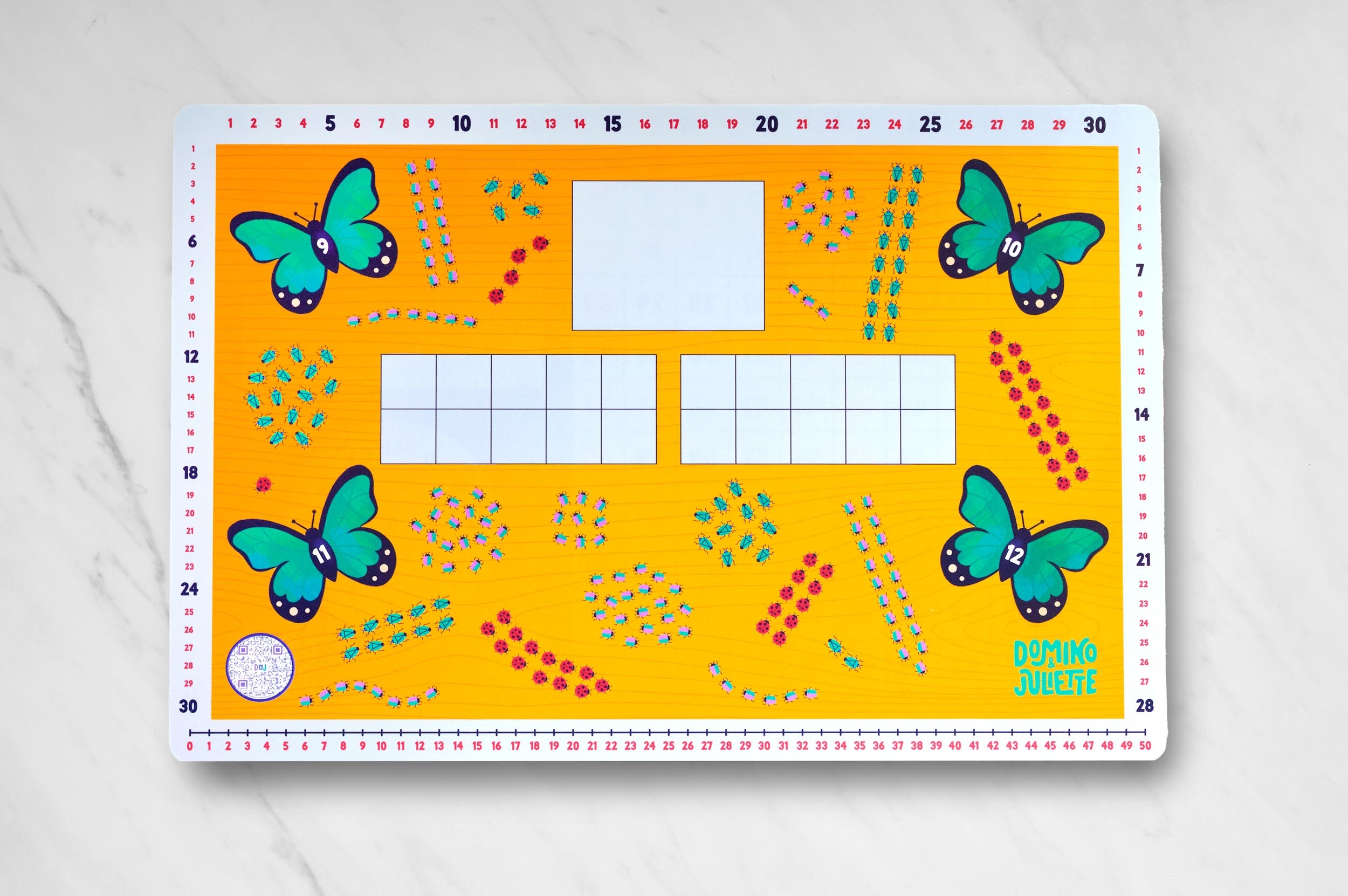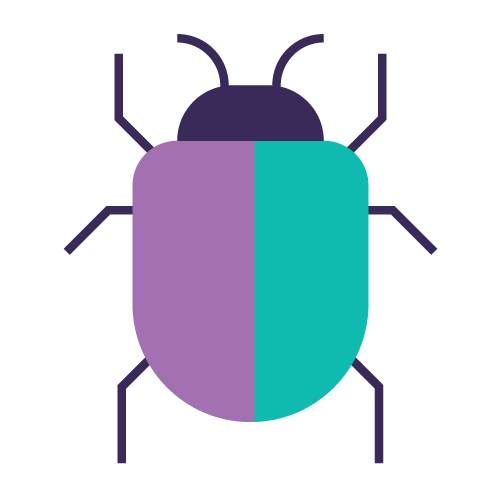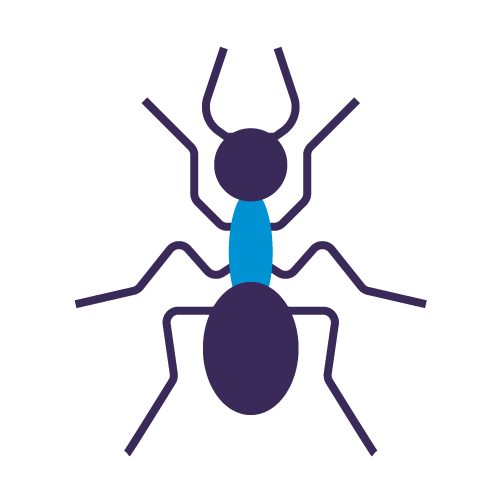
Welcome to the Bright Idea Zone!One toy, many ways to play
Discover a multitude of bright ideas for each placemat and keep the fun fresh. Designed by educational experts and sorted by age and ability, these activities help keep little minds engaged and growing.
For offline play, click to download the printer-friendly version of this page, as well as your bonus printable tools, and begin your learning adventure today!

Caught! No need for a bug catcher, we’ve already caught plenty of bugs and butterflies for your child to ooo and ahhh over right here, right now. Better yet, flying around this mat includes learning activities targeting estimation, addition and subtraction, and number sense. Expanding math skills has never been more unforgettable, and that’s what we’re going for!

Get Those Magnifiers Out and Let’s Take A Closer Look At The Math!
- Estimation using the bug groups: Do you think this group of bugs has more or less than 5 bugs? Why do you think that?
- How many bugs do you see in this group? Can you find that number on the number line?
- Count the number of bugs and place the corresponding D&J 123 Find & Fit puzzle piece on top. Alternatively, you can place a printable on top or older children can write the number on a Post-it note.
- Show it: Ask, “How many bugs are in this group?” 14. “Can you show me that number by putting the correct D&J 123 Find & Fit number puzzle piece in the square?” “Can you make that number using D&J bingo chips in the ten frames?” “Yes, I see one group of ten and four additional ones. Where is the number on the number line?” Put a clothespin or a marker on the number line.
- Addition using the ten frame: Select two groups of bugs less than or equal to 10. “How many total bugs do you see in this group? How many are in the other group? Let’s add these two groups together using the ten frames.”
- Addition using the number line: “How many total ladybugs can you find?” Coach the child to count a group, find that number on the number line and mark it using a clothespin. Allow your child to pick another group and count the bugs and then add that number to the total on the number line by moving up the number line.
- Teen numbers: Use the D&J printable group of 10 bugs. Place it next to a group of bugs (less than 10, in this example we have chosen a group of 3) and ask how many total bugs there are. “Yes, a group of 10 bugs and a group of 3 bugs is 13!”
- One more and less: Count the number of bugs in a group and point to the number on the number line. For example, 7. Say, “If two more green bugs joined this group, how many would there be?” 9!
- Comparing numbers: Count two groups of bugs. “Which of these two groups has more bugs?” “How many more?”
- Practice subtraction by using yellow playdough to cover up bugs. “Here are 8 bugs. Three of them flew away.” Cover with 3 with playdough. “Now how many bugs are there?”
- Skip counting: Practice skip counting using the groups of 2 to count the bugs. “See how these bugs are lined up in groups of 2? Let's use our skip counting to count the group! 2, 4, 6…” To practice skip counting by 5s, reference the top border and then encourage kids to count how many spots are in each group of ladybugs. Count by 5s using the ladybug’s spots.

Winging It With Butterfly Math
- Number composition: Point to a large green butterfly and identify the number in the center. We’ll use the one numbered 10. Instruct the child to place 10 beads/small buttons/cereal pieces on the butterfly wings. Once they have completed the exercise talk through the composition, “Yes 5 and 5 equals 10 what is another way we can make 10 on this butterfly?” Children can write out the corresponding number sentences and see how many different combinations they can create. For a sensory experience you can also create these markings on the butterfly using tiny pieces of playdough.
- Matching: match the butterflies with your D&J 123 Find & Fit number puzzles or D&J number printables.
- Counting: Using butterfly number 9, place your D&J 123 Find & Fit number pieces on each wing - one less and one more. On the left wing, the child would place an 8, on the right wing the child would place 10.
- Counting: Practice counting out loud starting from a random number. Using butterfly number 11, encourage the child to start at the number inside of the butterfly and then count up to 20. “11, 12, 13, 14…”

Skip Around The Trim!
Engage in some conversations about skip counting using the placemat border. What are some observations? Discuss how the bold number appears every 5th , 6th or 7th number.
Provide examples of skip counting using these patterns and do some additional practice/counting together:
- Fives: Using minutes on the clock. Point to the hours on the clock and skip count the minutes. Using nickels, show how you can count money using 5s (and how the knowledge of skip counting helps you add up a quarter and 2 nickels “25, 30, 35.”).
- Sixes: Using hours (12 and 24) discuss how the patterns allow you to add hours in a day (or multiple days).
- Sevens: Using days in a week. Discuss how 3 weeks have 7, 14, 21 days.
- Extend the counting beyond the trim (5, 10, 15, 20, 25, 30…).
- Once the child is comfortable with the patterns, work to identify them on the number line (this will be more challenging since they are not bolded).
- There are other ways to get creative with the numbers on the edge (not related to skip counting). For example, you could pile the correct number of coins on the bold numbers. On the number 10 a child can place a nickel and 5 pennies. On the number 18 they could place a dime, a nickel and 3 pennies.

Detective Work
- Guess my number on the number line: Cover a number(s) and have the child say which numbers are covered and how they know.
- Secret Numbers: Pick a secret number and encourage the other person to guess a number. The only clues that are given are saying if the secret number is greater than or less than the numbers. For example: “It is 17?” “No, it is less than 17.” “Is it 2?” “It is greater than 2.” etc.

Keep It Coming With 10 Frames
These ten frames can be used for a variety of additional activities:
Adding groups of bugs together:
- Represent the number in one of the green butterflies by using two different colored D&J bingo chips. For example, if showing 9, the child could use 4 red chips and 5 blue chips on the ten frame.
Working with teen numbers:
- Fill up one ten frame with D&J bingo chips (or beads, snack pieces) and place your D&J 123 Find & Fit number pieces 1 and 0 in the square above. Place another amount into the 2nd ten frame and encourage the child to count. “Yes, there are 8 in this frame.” Next, emphasize 10 and 8 make 18 and move the puzzle pieces. “We never have to move this 1 because it represents the one set of ten.”
- Place your D&J 123 Find & Fit number pieces in the square above the ten frames to represent a number between 1 and 20. Have the child build that number in the ten frames using D&J bingo chips or snack pieces.